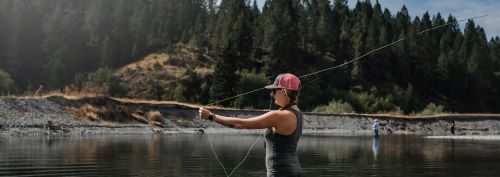When most fly fishers think about catching trout in rivers, the first fly patterns that come to mind are imitations of mayflies, caddisflies, or stoneflies. Depending on the productivity of the water and quality of habitat, these aquatic insects can make up a substantial portion of the diet of trout, char, and other fish species living in moving waters.
However, when trout and char grow to bigger sizes, they become very opportunistic feeders. Larger food items like forage fish, crayfish, and even animals (such as mice or voles) can become major menu items. The fry and smolts of all five species of Pacific salmon, during their out-migrations to the ocean, are also targeted by trout and char.
Piscivorous (fish-eating) species
Resident rainbow, brown, westslope cutthroat, and bull trout, along with resident and anadromous coastal cutthroat and Dolly Varden, can all become piscivorous (fish-eaters) at some point in their lives. Dolly Varden, bull trout, and brown trout are particularly well-known for their aggressive feeding behaviour when it comes to forage fish.
Forage fish like sculpins and minnows (including dace, suckers, chub, and shiners) are commonly found co-existing with trout and char in many river systems throughout B.C. and other parts of North America. These non-game fish species are in direct competition with trout and char for food. It is only when the game fish attain a large-enough size that their competitors now become a source of food.

Forage or Baitfish Patterns to Have in Your Fly Box
Whenever fishing a river, fly fishers should always have forage or baitfish patterns in their fly boxes. Depending upon the species, forage fish can be found in all habitat types within a river; however, pools and runs provide some of the best cover for them. As baitfish are typically holding close to or even within the rocky bottom substrate, their fly patterns should normally be fished close to the bottom. This is especially true for sculpins, which are one of the most common forage-fish food sources.

Fly Lines to Use with Bait or Forage Fish Patterns
Sink-tip or shooting-head sinking fly lines are often the go-to lines to get your fly down in the river’s water column. Sink-tip lines are available in various sinking tip lengths and sink-rates. Depth and speed of water are prime considerations when selecting the right density of sink-tip line. Multi-tip lines come with a selection of interchangeable sink-tips of various sinking rates. The goal is to have your forage-fish imitation swimming just off the bottom as it swings through the water. Fish these patterns on a short leader: 120 to 150 centimetres (four to five feet) is ample. A leader that is too long will allow the fly to swim above the sinking part of the fly line.
Fly Patterns that Imitate Forage Fish
There are many commercially tied fly patterns that imitate the various forage fish. Anglers who tie their own flies will find a huge variety of materials to create that perfect sculpin or chub imitation. Go-to suggestive patterns include Woolly Buggers, Muddler Minnows, Zonkers, and Clouser Minnows. Don’t be afraid to finish fishing a piece of water by swinging one of these patterns through. You may be pleasantly surprised.

Salmon Smolt and Fry Patterns
Migrating salmon fry or smolts offer another short but exciting fly-fishing opportunity. Trout and char ambush large schools of juvenile salmon as they make their perilous journey to the ocean. Casting and retrieving fry or smolt patterns through a school of rainbow, cutthroat, or char that are slashing into a school of pink fry or chinook smolts is an incredible experience. With the abundance of the real fry or smolts, trout and char can be very selective as to what they will chase. Your patterns need to be very close to imitating the real deal, or you will get lots of refusals – but that’s why we call it fishing!

Author: Brian Chan, Freshwater Fisheries Society of BC Ambassador
Photos: Brian Chan, Brian Briscoe, Lacey Pukas
